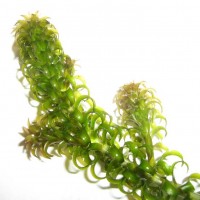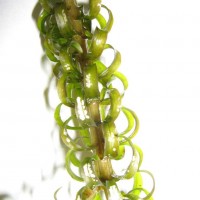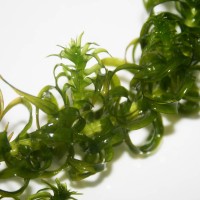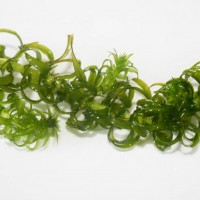
Curly Waterweed - Lagarosiphon major
Expand and collapse the sections below by clicking on the title or + / - icons.
Short description of Lagarosiphon major, Curly Waterweed
Curly waterweedis a perennial, submerged dioecious plant with branched stems and strongly recurved leaves alternate or spiralled or rarely in whorls up the stem., with two rows of fibre-like cells on the margins with > 50 teeth on each side.
Impact summary: Lagarosiphon major, Curly Waterweed
The actual impact of curly waterweed is difficult to assess; it certainly occupies large areas of the beds of standing and slow-flowing water bodies which might otherwise support native plants.
Habitat summary: Lagarosiphon major, Curly Waterweed
In its native range, it occurs streams and ponds at high altitudes. In GB, it occurs in still or very slow-flowing water, principally in eutrophic, calcareous canals, ponds, lakes and gravel pits.
Overview table
| Environment | Freshwater |
|---|---|
| Species status | Non-Native |
| Native range | Southern Africa |
| Functional type | Land plant |
| Status in England | Non-Native |
| Status in Scotland | Non-Native |
| Status in Wales | Non-Native |
| Location of first record | v.c.30 (Nr. Arlesley) |
| Date of first record | 1944 |
Origin
Curly waterweed is a native of a restricted area of southern Africa, in southern Zimbabwe, Zambia, Lesotho, Botswana, Swaziland and RSA.
First Record
Curly waterweed was first recorded in GB in a gravel pit near Arlesey, in Hertfordshire in 1944.
Pathway and Method
The most likely pathway for entry into the wild in GB is an outdoor pond to have been stocked with this species and then fragments transferred to a natural water body, either deliberately or accidentally on machinery, recreational equipment or clothing.
Species Status
Curly waterweed has become established in the wild in Australia, Belgium, France, Germany, Ireland, Italy, Netherlands, New Zealand, Potugal, Reunion, Rodriguez Island, Spain, Switzerland and GB. It is not generally considered troublesome, except in New Zealand, GB and occasionally in parts of its native range. In GB, it took a long time to spread, with records from fewer than 150 10km squares in 1995, however data collection for the New Atlas and subsequent recording have shown that it has undergone a dramatic increase, to nearly 431 10km squares by 1999 to 713 by 2017.
Dispersal Mechanisms
All plants in GB are female; all dispersal must therefore be by vegetative means and is likely to be by fragments dispersed by water or on machinery, recreational equipment, and boats.
Reproduction
L. major is a dioecious plant and has the ability to reporduce by both vegetative and sexual means, though only vegetative reproduction has been observed outside of its native range where all plants appear to be female.
Known Predators/Herbivores
A number of invertebrates which feed on L. major have been identified, but there are no species which are known to feed on this species in GB.
Resistant Stages
None known.
Habitat Occupied in GB
In GB, it occurs in still or very slow-flowing water, principally in eutrophic, calcareous canals, ponds, lakes and gravel pits.
Curly waterweedis widely established south of a line from Cumbria to the Tees, apart from north-west Wales, and low-lying parts of eastern England. There are scattered populations further north, as far as Orkney, as well as a number of widely scttered populations in Ireland.
Environmental Impact
Dense growth may deplete oxygen levels in water, disrupt natural erosion-deposition processes, disrupt the movement of animals, out-compete native aquatic plants, block light needed for photosynthesis, disrupt predator - prey relationships, prevent wind mixing, leading to localised oxygen depletion, create mosquito breeding areas and increase water temperature by absorbing sunlight, while die back can increase nutrient loads to the water.
Health and Social Impact
Dense growth of curly waterweed can restrict activities such as swimming and angling, prevent or disrupt sailing and other water sports, while storms can tear loose the weed and deposit large masses of rotting vegetation on beaches, spoiling their amenity value.
Economic Impact
The potential costs of control of dense populations could reach £1000 per hectare. It can have other impacts with economic consequences, such as blocking intakes of hydro-electric systems, reduce water storage capacity of deep-water reservoirs, restrict the passage of boats and preclude commercial exploitation of water bodies.
Identification
Stace, C.A. (2010) New flora of the British Isles, Third Edition, Cambridge University Press, Cambridge.
Lansdown, R.V. (2009) A field guide to the riverine plants of Britain and Ireland. Ardeola, Stroud, Gloucestershire.
Biology, ecology, spread, vectors
Non-native species secretariat risks and action plans (https:secure.fera.defra.gov.uk nonnativespecies downloadDocument.cfm?id=241).
Management and impact
Non-native species secretariat risks and action plans (https:secure.fera.defra.gov.uk nonnativespecies downloadDocument.cfm?id=241).
General
Non-native species secretariat risks and action plans (https:secure.fera.defra.gov.uk nonnativespecies downloadDocument.cfm?id=241).
https://www.cabi.org/isc/datasheet/30548
https://secure.fera.defra.gov.uk/nonnativespecies/downloadDocument.cfm?id=241
Spotted this species?
Distribution map
View the Distribution map for Curly Waterweed, Lagarosiphon major from BSBI
ID Sheet
ID Sheet for Lagarosiphon major . See a full list of non-native species ID Sheets.
Risk assessment
Risk assessment for Lagarosiphon major. See a full list of non-native species Risk assessments.
Legislation
This species is:
- A Species of Special concern
- Listed under Schedule 9 of the Wildlife and Countryside Act 1981
Read more about Non-native species legislation.




